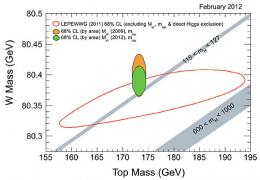|
World's best measurement of W boson mass tests Standard Model,
Higgs boson limits
February 23, 2012 by
Tona Kunz

PhysOrg.com) -- Just as firemen use different
methods to narrow the location of a person trapped in a
building, scientists employ two techniques to find the hiding
place of the theorized Higgs particle: direct searches for Higgs
interactions and precision measurements of other particles and
forces.
The new CDF result for the W boson mass, combined
with the world's best value for the top quark mass, restricts
the Higgs mass to the green area, requiring it to be less than
145 GeV/c2. Direct searches have narrowed the allowed Higgs mass
range to 115-127 GeV/c2.
Today, scientists from the CDF collaboration have
unveiled the world's most precise measurement of the W boson mass,
based on data gathered at theTevatron
accelerator. The precision of this measurement surpasses all
previous measurements combined and restricts the space in which
theHiggs
particle should
reside according to the Standard Model, the theoretical
framework that describes all known subatomic
particles and
forces.
The result comes at a pivotal time, just a couple
of weeks before physicists from experiments at the Tevatron and
the Large
Hadron Collider in
CERN plan to present their latest direct-search results in the
hunt for the Higgs at the annual conference on Electroweak
Interactions and Unified Theories known as Rencontres de Moriond
in Italy.
CDF collaborators have measured the mass of the W
boson with a precision of 0.02 percent and found the particle's
mass to be 80387 +/- 19 MeV/c2. They measured the
particle's mass in six different ways, which all match and
combine to produce the final result. CDF collaborator and Duke
University Professor Ashutosh Kotwal will present the details of
the measurement at a special seminar at Fermilab today, and
additional information will be posted after the seminar on the
CDF website.
Direct Higgs search limits established by the LEP
experiments many years ago require the Higgs
boson to be
heavier than 114 GeV/c2. The new W mass measurement and the
latest precision determination of the mass of thetop
quark from
Fermilab triangulate the location of the Higgs particle and
restrict its mass to less than 145 GeV/c2. This is in
excellent agreement with the latest direct searches at the LHC,
which constrain the Higgs mass to less than 127 GeV/c2,
and direct-search limits from the Tevatron, which point to a
Higgs mass of less than 156 GeV/c2.
"The result couldn't align more with the direct
Higgs search results than this," said CDF co-spokesman Rob
Roser. "It indicates that if the Higgs boson exists, it should
be right where we are looking."
The DZero collaboration at the Tevatron expects
to release its updated W mass result in the next couple of
weeks.
The Higgs boson is the last undiscovered
component of the Standard Model and theorized to give
fundamental particles mass. The upcoming results for the Higgs
hunt combined with this new measurement of the W boson mass will
provide the strongest test yet of the accuracy of the Standard
Model.
If experimenters at the Tevatron and LHC didn't
find the Higgs where the W boson mass implies it should be, it
would suggest our understanding of nature as embodied in the
Standard Model is wrong. It would imply the existence of other
undiscovered particles or of undiscovered forces that govern how
matter behaves.
"This is one of the most important precision
measurements of
the Tevatron because it serves as a stress test for the Standard
Model - all sort
of new physics models might in principle show up in the W mass
measurement," said CDF co-spokesman Giovanni Punzi.
The CDF and DZero results for the W mass likely
will be one of the long-lasting scientific legacies of the
Tevatron.
Provided by Fermilab (news : web)
Source: Physorg
1 2 3 4 5 6 7 8 9 10 Newest
articles
|

